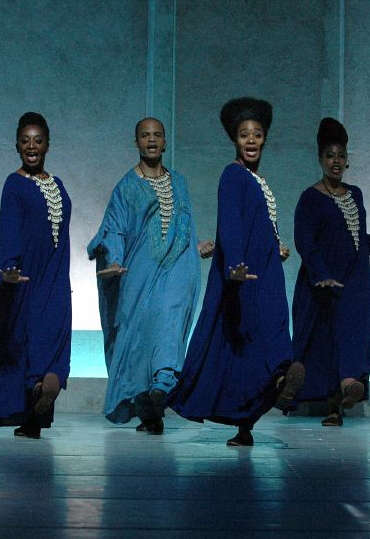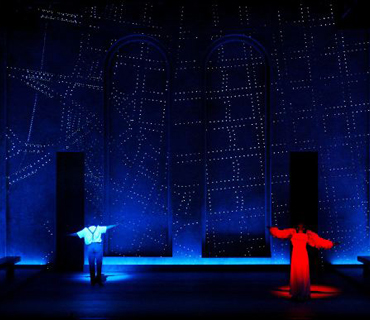| | testo italiano | | ||||
|
[ conversations ]
|
Robert Wilson,
Glimpsing Beyond The Impossible
|
|||
|
Gertrude Stein (in 1998 you directed the striking “open work” Saints and Singing written in 1922 ) in analyzing the works of Cezanne and Flaubert, as well as
Pound, used to indicate the necessity of reuniting the differences in one flow.
In your work do you see the possibility of putting the differences in a single
frame ?
I think André Malraux was right when he said that Western theater had been “bound by literature”. And I think what he meant was that so much of the direction we see in it is
simply text, something that is written word. And what I’ve tried to do in my theater is to show that what we see is what we see and what
we hear is what we hear. And what we see can be as important as what we hear.
As in life. And that there is a theatrical language for something we see. That
isn’t gesture, it isn’t stage set or whatever, and more in line with world theater. If we look at the
theater of Africa, if we look at Chinese classical theater, if we look at the
theater of Japan, if we look at the theater of Indonesia, India . . . A large
part of the world has a formal theater where tradition is a theatrical language
in terms of what we see.
Your shows often seem to create gaps, openings, vanishing points that remain
intentionally disclosed and half-open to the interpretation or to the visions
of your audience. Do you agree with this reading?
As I said before, my work is, in most cases, formal. It is not interpretative.
To me interpretation is not the responsibility of the director, the author or
the performer: interpretation is for the public.
In the theater there is no separation between any art form. It’s all a part of the whole. My use of light, my work with the actors, set,
costumes, elements, are all part of a visual artistry. In a like way, the music
is a part of the whole. To me the theater is something visual, aural,
inseparable. By comprehending each other, the aural and visual elements can
reinforce each other, make each other stronger. The whole is more than the sum
of its parts.
What do you think about your audience? Has it changed over the years?
I can’t say.
Your theater has always had a tension to the memory, a fullness of archivistic
rigor, a kind of archaeological-monumental memory (in Nietzsche’s words); could you give us an outline of your method of work (charged with
combinations, crossings, breakings, quotations, coolings, suspensions,
repetitions, constructions and deconstructions. In other words, a scene that
can become a transformation of the world as a
“magic place ” as the Sufi poet Rumi – whom you love so much - would say)?
I think what the individual sees when the eye is closed is something to do with
light and color, and something to do with the fragmentation of human emotion.
In studies made by Daniel Stern, he took films of mothers responding when their
babies started to cry, and looked at them frame by frame, in each second there
are 32 frames. And he would see that in one frame the mother seems to be
lunging for the child, and the child looks terrified. Maybe in the next frame
the mother has another emotion, and the child another. In the next frame,
another. So many emotional changes in just one second of time. For me, that is
the lesson of the blink of the eye. Maybe the body and the emotions are working
faster than the mind can keep up with.
You devote much of your professional commitment to the activities of the
Watermill Center, a laboratory of arts and humanities located in eastern Long
Island. What are this center’s main activities of research and production?
Now the Center is a year-round facility. I am not interested in creating a school. I don’t teach a method at Watermill. I like to consider it as an international
laboratory for interdisciplinary collaborations, where art, technology,
business and the humanities interact in a spirit of innovation. The Center was
created to provide unique opportunities for young people to develop as artists,
to live
|
|
|
 | |
|
|
|
The temptations of Saint Anthony, photo by Stephanie Berger
|
||
|
|
|
and work together forming a special community, to define and explore their own interests while observing and collaborating with established professionals.
Allow me a somewhat predictable and unsophisticated question. People adore you
in Italy! In Italy, at different times, you have realized several
collaborations. So, what do you think about Italy?
I have not spent enough time in Italy to get to know the work of young
directors. I would very much like to do so as I am very fond of the Italian
sense for art.
When the subject is avant-garde or classic theater, your name comes up. When
they talk about scenic-technical inventions, you are there. Your works can be
seen in most contemporary arts museums or galleries (especially video-works).
Not to mention architecture and design. Where are you heading for now? A new
“beyond”? Where is your next contamination going? How are you amplifying your “total work”? Which horizons are your visionary eyes scanning?
People ask me often which part of my work do I think is the most important not
only for me and for art history as well. My answer is always the same: the next
one.
| ||
|
|
|
| ||
|
|
|
 |
||
|
|
|
The temptations of Saint Anthony, photo by Stephanie Berger
|
||
|
Translation of introduction and questions by Antonella Capasso and Daniela Baldascino.
Our sincere thanks to Elisabetta Di Mambro for help and support. | ||||
| [1] [2] (3) | |||

|

| ||